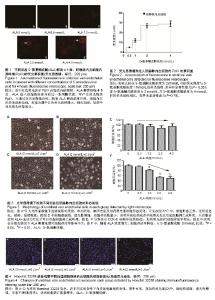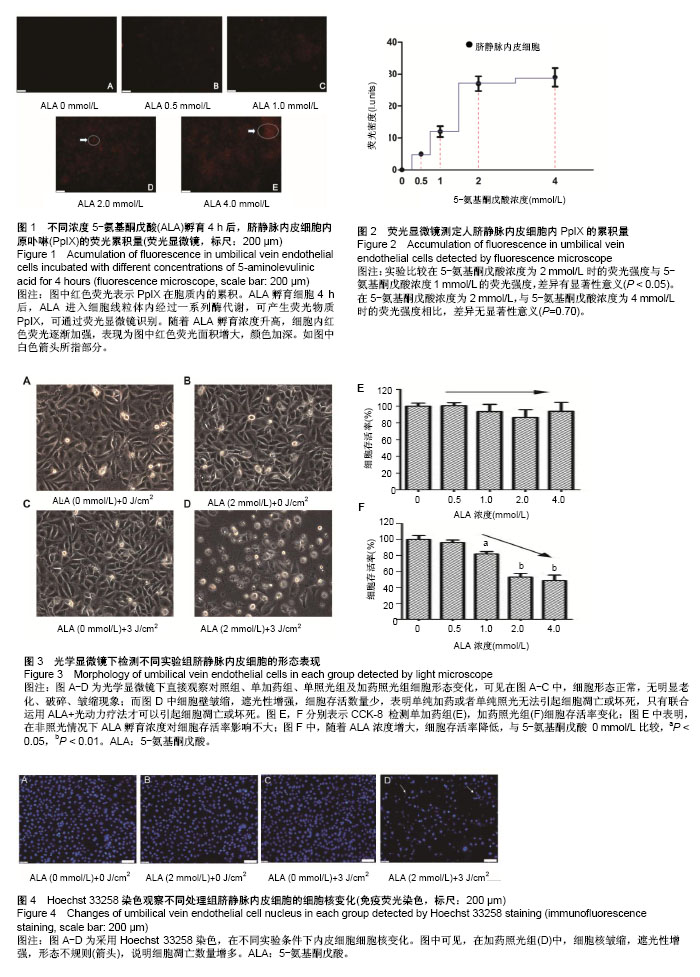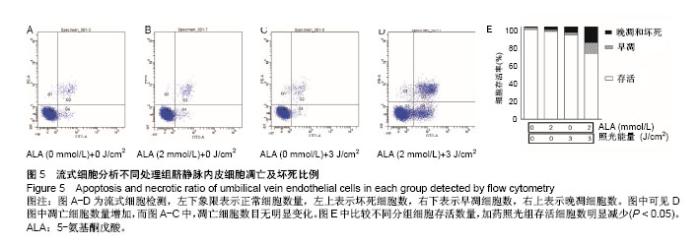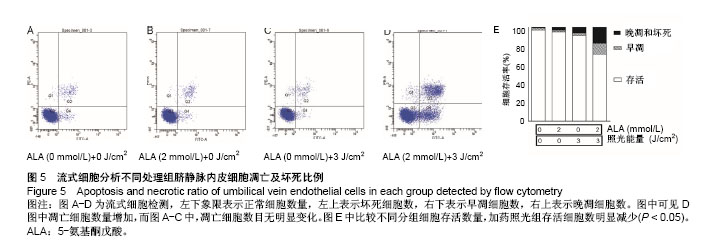Chinese Journal of Tissue Engineering Research ›› 2018, Vol. 22 ›› Issue (36): 5840-5845.doi: 10.3969/j.issn.2095-4344.0697
Previous Articles Next Articles
Aminolevulinic acid photodynamic therapy can significantly inhibit the growth of endothelial cells and induce cell apoptosis
Ge Wenjia, Ma Xiaorong, Ouyang Tianxiang
- (Department of Plastic Surgery, Xinhua Hospital Affiliated to Shanghai Jiao Tong University School of Medicine, Shanghai 200092, China)
-
Received:2018-08-07Online:2018-12-28Published:2018-12-28 -
Contact:Ouyang Tianxiang, Department of Plastic Surgery, Xinhua Hospital Affiliated to Shanghai Jiao Tong University School of Medicine, Shanghai 200092, China -
About author:Ge Wenjia, Department of Plastic Surgery, Xinhua Hospital Affiliated to Shanghai Jiao Tong University School of Medicine, Shanghai 200092, China -
Supported by:the Scientific Research Foundation of Health Bureau of Shanghai, No. 201540374
CLC Number:
Cite this article
Ge Wenjia, Ma Xiaorong, Ouyang Tianxiang . Aminolevulinic acid photodynamic therapy can significantly inhibit the growth of endothelial cells and induce cell apoptosis[J]. Chinese Journal of Tissue Engineering Research, 2018, 22(36): 5840-5845.
share this article

2.1 随着5-氨基酮戊酸浓度增高,脐静脉内皮细胞内荧光累积量逐渐增高 加入不同浓度梯度5-氨基酮戊酸避光孵育4 h后,荧光显微镜下观察,细胞内的荧光累积值随着5-氨基酮戊酸的浓度升高,见图1,在浓度为2.0 mmol/L时,达到高峰,随后5-氨基酮戊酸浓度升高,荧光累积量无明显变化,表明内皮细胞转化5-氨基酮戊酸能力有限,到达阈值后,增加药物浓度不改变细胞内荧光累积量,见图2。 2.2 光学显微镜下不同处理组细胞形态变化 光学显微镜下观察照光后细胞形态变化与细胞毒性实验相吻合。对照组,单加药组及单照光组均未见细胞形态与正常内皮细胞有明显变化,而加药照光组细胞发现明显明显皱缩,破碎,折光性增强,见图3A-D。 2.3 细胞毒性实验检测发现处理组细胞活性被显著抑制 通过细胞毒性实验可以检测出,单加药组对于内皮细胞的生长没有明显抑制,照光后,低浓度加药组细胞活性没有明显影响,而当5-氨基酮戊酸浓度到达2 mmol/L时,对内皮细胞生长有明显的抑制作用(P < 0.01;见图3E,F)。 2.4 Hoechst 33258染色显示加药照光组细胞核固缩增加Hoechst 33258染色结果表明在对照组、单加药组、单照光组细胞核形态规则,与正常细胞核相比没有明显变化,在加药照光组,细胞核发生明显的固缩,折光性增强等细胞凋亡变化,见图4。 2.5 流式检测发现加药照光细胞凋亡增加 流式细胞仪检测发现对照组和单加药组及单照光组,细胞没有发生明显凋亡和坏死,而在加药照光组细胞发生明显的凋亡和坏死,以凋亡为主(P < 0.05),见图5。"

| [1] Ehrlich HP, Desmouliere A, Diegelmann RF, et al. Morphological and immunochemical differences between keloid and hypertrophic scar. Am J Pathol. 1994;145:105-113. [2] Fujita AK, Rodrigues PG, Requena MB, et al. Fluorescence evaluations for porphyrin formation during topical PDT using ALA and methyl-ALA mixtures in pig skin models. Photodiagnosis Photodyn Ther. 2016;15:236-244. [3] Chun Q, Zhiyong W, Fei S, et al. Dynamic biological changes in fibroblasts during hypertrophic scar formation and regression. Int Wound J. 2016;13:257-262. [4] Zhang Z, Chen Y, Ding J, et al. Biocompatible 5-Aminolevulinic Acid/Au Nanoparticle-Loaded Ethosomal Vesicles for In Vitro Transdermal Synergistic Photodynamic/ Photothermal Therapy of Hypertrophic Scars. Nanoscale Res Lett. 2017;12:622. [5] Wang XQ, Liu YK, Qing C, et al. A review of the effectiveness of antimitotic drug injections for hypertrophic scars and keloids. Ann Plast Surg. 2009;63:688-692. [6] Gauglitz GG, Korting HC, Pavicic T, et al. Hypertrophic scarring and keloids: pathomechanisms and current and emerging treatment strategies. Mol Med 2011;17:113-125. [7] Stylli SS, Howes M, MacGregor L, et al. Photodynamic therapy of brain tumours: evaluation of porphyrin uptake versus clinical outcome. J Clin Neurosci. 2004;11:584-596[8] O'Connell KA, Okhovat JP, Zeitouni NC. Photodynamic Therapy for Bowen's Disease (Squamous Cell Carcinoma in situ) Current Review and Update. Photodiagnosis Photodyn Ther. 2018. DOI:10. 1016/j.pdpdt.2018.09.009.[9] van der Veer WM, Niessen FB, Ferreira JA, et al. Time course of the angiogenic response during normotrophic and hypertrophic scar formation in humans. Wound Repair Regen. 2011;19:292-301.[10] Chen B, Pogue BW, Luna JM, et al. Tumor vascular permeabilization by vascular-targeting photosensitization: effects, mechanism, and therapeutic implications. Clin Cancer Res. 2006;12:917-923. [11] Peng Q, Berg K, Moan J, et al. 5-Aminolevulinic acid-based photodynamic therapy: principles and experimental research. Photochem Photobiol. 1997;65:235-251.[12] Cohen DK and Lee PK. Photodynamic Therapy for Non-Melanoma Skin Cancers. Cancers (Basel). 2016. DOI:10. 1016/j. pdpdt.2018.09.009.[13] Wennberg AM, Stenquist B, Stockfleth E, et al. Photodynamic therapy with methyl aminolevulinate for prevention of new skin lesions in transplant recipients: a randomized study. Transplantation. 2008;86:423-429. [14] Jarvi MT, Niedre MJ, Patterson MS, et al. Singlet oxygen luminescence dosimetry (SOLD) for photodynamic therapy: current status, challenges and future prospects. Photochem Photobiol. 2006; 82:1198-1210. [15] Chang M, Ma X, Ouyang T, et al. Potential molecular mechanisms involved in 5-aminolevulinic acid-based photodynamic therapy against human hypertrophic scars. Plast Reconstr Surg. 2015;136:715-727.[16] Kwak DH, Bae TH, Kim WS, et al. Anti-vascular endothelial growth factor (bevacizumab) therapy reduces hypertrophic scar formation in a rabbit ear wounding model. Arch Plast Surg. 2016;43:491-497. [17] Ge X, Zhao L, He L, et al. Vascular endothelial growth factor receptor 2 (VEGFR2, Flk-1/KDR) protects HEK293 cells against CoCl(2) -induced hypoxic toxicity. Cell Biochem Funct. 2012;30:151-157. [18] Tschen EH, Wong DS, Pariser DM, et al. Photodynamic therapy using aminolaevulinic acid for patients with nonhyperkeratotic actinic keratoses of the face and scalp: phase IV multicentre clinical trial with 12-month follow up. Br J Dermatol. 2006;155:1262-1269. [19] Lian N, Li T. Growth factor pathways in hypertrophic scars: Molecular pathogenesis and therapeutic implications. Biomed Pharmacother. 2016;84:42-50. [20] Armour A, Scott PG and Tredget EE. Cellular and molecular pathology of HTS: basis for treatment. Wound Repair Regen. 2007;15 Suppl 1:S6-S17. [21] Hembry RM and Ehrlich HP. Immunolocalization of collagenase and tissue inhibitor of metalloproteinases (TIMP) in hypertrophic scar tissue. Br J Dermatol. 1986;115:409-420. [22] Cao PF, Xu YB, Tang JM, et al. HOXA9 regulates angiogenesis in human hypertrophic scars: induction of VEGF secretion by epidermal stem cells. Int J Clin Exp Pathol. 2014; 7:2998-3007. [23] Bruscino N, Rossi R, Dindelli M, et al. Therapeutic Hotline: Facial skin rejuvenation in a patient treated with photodynamic therapy for actinic keratosis. Dermatol Ther. 2010;23:86-89. [24] Bruscino N, Lotti T and Rossi R. Photodynamic therapy for a hypertrophic scarring: a promising choice. Photodermatol Photoimmunol Photomed. 2011;27:334-335. [25] Landes R, Illanes A, Goeppner D, et al. A study of concentration changes of Protoporphyrin IX and Coproporphyrin III in mixed samples mimicking conditions inside cancer cells for Photodynamic Therapy. PLoS One. 2018;13:e0202349. [26] Coupienne I, Fettweis G, Rubio N, et al. 5-ALA-PDT induces RIP3-dependent necrosis in glioblastoma. Photochem Photobiol Sci. 2011;10:1868-1878. [27] Yang X, Palasuberniam P, Kraus D, et al. Aminolevulinic acid-based tumor detection and therapy: molecular mechanisms and strategies for enhancement. Int J Mol Sci. 2015;16:25865-25880. [28] Zhang Z, Chen Y, Xu H, et al. 5-Aminolevulinic acid loaded ethosomal vesicles with high entrapment efficiency for in vitro topical transdermal delivery and photodynamic therapy of hypertrophic scars. Nanoscale 2016;8:19270-19279. [29] Fujino M, Nishio Y, Ito H, et al. 5-Aminolevulinic acid regulates the inflammatory response and alloimmune reaction. Int Immunopharmacol. 2016;37:71-78. [30] da Luz Dias R, Basso B, Donadio MVF, et al. Leucine reduces the proliferation of MC3T3-E1 cells through DNA damage and cell senescence. Toxicol In Vitro. 2018;48:1-10. |
| [1] | Pu Rui, Chen Ziyang, Yuan Lingyan. Characteristics and effects of exosomes from different cell sources in cardioprotection [J]. Chinese Journal of Tissue Engineering Research, 2021, 25(在线): 1-. |
| [2] | Geng Qiudong, Ge Haiya, Wang Heming, Li Nan. Role and mechanism of Guilu Erxianjiao in treatment of osteoarthritis based on network pharmacology [J]. Chinese Journal of Tissue Engineering Research, 2021, 25(8): 1229-1236. |
| [3] | Pei Lili, Sun Guicai, Wang Di. Salvianolic acid B inhibits oxidative damage of bone marrow mesenchymal stem cells and promotes differentiation into cardiomyocytes [J]. Chinese Journal of Tissue Engineering Research, 2021, 25(7): 1032-1036. |
| [4] | Li Shibin, Lai Yu, Zhou Yi, Liao Jianzhao, Zhang Xiaoyun, Zhang Xuan. Pathogenesis of hormonal osteonecrosis of the femoral head and the target effect of related signaling pathways [J]. Chinese Journal of Tissue Engineering Research, 2021, 25(6): 935-941. |
| [5] | Xu Yinqin, Shi Hongmei, Wang Guangyi. Effects of Tongbi prescription hot compress combined with acupuncture on mRNA expressions of apoptosis-related genes,Caspase-3 and Bcl-2, in degenerative intervertebral discs [J]. Chinese Journal of Tissue Engineering Research, 2021, 25(5): 713-718. |
| [6] | Zhang Wenwen, Jin Songfeng, Zhao Guoliang, Gong Lihong. Mechanism by which Wenban Decoction reduces homocysteine-induced apoptosis of myocardial microvascular endothelial cells in rats [J]. Chinese Journal of Tissue Engineering Research, 2021, 25(5): 723-728. |
| [7] | Liu Qing, Wan Bijiang. Effect of acupotomy therapy on the expression of Bcl-2/Bax in synovial tissue of collagen-induced arthritis rats [J]. Chinese Journal of Tissue Engineering Research, 2021, 25(5): 729-734. |
| [8] | Xie Chongxin, Zhang Lei. Comparison of knee degeneration after anterior cruciate ligament reconstruction with or without remnant preservation [J]. Chinese Journal of Tissue Engineering Research, 2021, 25(5): 735-740. |
| [9] | Jiang Xin, Qiao Liangwei, Sun Dong, Li Ming, Fang Jun, Qu Qingshan. Expression of long chain non-coding RNA PGM5-AS1 in serum of renal transplant patients and its regulation of human glomerular endothelial cells [J]. Chinese Journal of Tissue Engineering Research, 2021, 25(5): 741-745. |
| [10] | Jiang Tao, Ma Lei, Li Zhiqiang, Shou Xi, Duan Mingjun, Wu Shuo, Ma Chuang, Wei Qin. Platelet-derived growth factor BB induces bone marrow mesenchymal stem cells to differentiate into vascular endothelial cells [J]. Chinese Journal of Tissue Engineering Research, 2021, 25(25): 3937-3942. |
| [11] | Su Liping, Lu Ziyang, Liu Li, Zhang Wei, Su Tianyuan, Hu Xiayun, Pu Hongwei, Han Dengfeng. C-jun, Cytc and Caspase-9 in the apoptosis of cerebellar granule neurons induced by diacetylmorphine in rats [J]. Chinese Journal of Tissue Engineering Research, 2021, 25(25): 3943-3948. |
| [12] | Zuo Zhenkui, Han Jiarui, Ji Shuling, He Lulu. Pretreatment with ginkgo biloba extract 50 alleviates radiation-induced acute intestinal injury in mice [J]. Chinese Journal of Tissue Engineering Research, 2021, 25(23): 3666-3671. |
| [13] | Zhang Liang, Ma Xiaoyan, Wang Jiahong. Regulatory mechanism of Shenshuai Yin on cell apoptosis in the kidney of chronic renal failure rats [J]. Chinese Journal of Tissue Engineering Research, 2021, 25(23): 3672-3677. |
| [14] | Xie Yang, Lü Zhiyu, Zhang Shujiang, Long Ting, Li Zuoxiao. Effects of recombinant adeno-associated virus mediated nerve growth factor gene transfection on oligodendrocyte apoptosis and myelination in experimental autoimmune encephalomyelitis mice [J]. Chinese Journal of Tissue Engineering Research, 2021, 25(23): 3678-3683. |
| [15] | Chen Siqi, Xian Debin, Xu Rongsheng, Qin Zhongjie, Zhang Lei, Xia Delin. Effects of bone marrow mesenchymal stem cells and human umbilical vein endothelial cells combined with hydroxyapatite-tricalcium phosphate scaffolds on early angiogenesis in skull defect repair in rats [J]. Chinese Journal of Tissue Engineering Research, 2021, 25(22): 3458-3465. |
| Viewed | ||||||
|
Full text |
|
|||||
|
Abstract |
|
|||||

